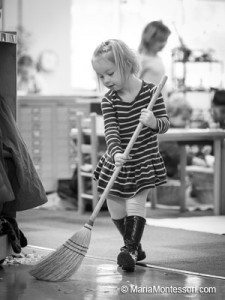


I had a humbling experience last week in my community of 3-6-year-olds – one of those moments that reminded me to put my faith in the power of the child’s own inner guide to lead them to the experiences they need for their own satisfying development.
It was mid-morning when I peeked out through the open porch door to check in on a child’s progress cleaning up a large spill. In an attempt to get to all of the water, this child had moved a shelf away from the wall and in the process tipped over a fairly large plant whose soil and the pot were now scattered all over the floor along with a container full of dried corn that the children had removed from corn cobs over the course of many months to feed to the backyard wildlife. Every corner of our screened-in porch was covered with this mix of corn, soil, and water. The child looked up at me, soil-covered mop in hand, and said, “The plant fell over.”
While I collected the fragments of the terracotta saucer from the floor, I took a few moments to breathe deeply and make a plan to support this clean-up endeavor. At this point, two girls eating snacks right near the porch door came to see what was going on. Their jaws dropped. And then they surprised me. They both scampered back into the room and returned moments later with brooms. “We can finish snack later,” one girl declared. “We’ll help clean this up,” said the other. Next came a troop of three of our youngest boys who frequently travel together to check out interesting commotions. Before I could stop them, the three boys all grabbed dustpans and brushes with cries of “We’ll help too!”
I realized that I wasn’t going to be able to walk away for quite some time, so I made eye contact with my assistant and let her know I would be on the porch for a while. Surprisingly, I began to relax. Looking back, I realize that I had unconsciously decided to let the experience unfold rather than try to “fix” things as efficiently as possible. I let go of the lessons I had been planning in my head and gave myself over to the six children there in front of me enthusiastically attempting to sweep up an inordinate amount of debris.
So I attempted to help manage the clean-up process as unobtrusively as I could, letting them problem-solve while offering a few ideas about how they might divide the task. I did have to nix a few suggestions (such as taking every single thing off the porch before sweeping, and all six of them sweeping in the same corner at once), but I let them take the lead. I found myself grinning as the older girls exclaimed things like, “This is going really fast because there are so many helpers!” and “We’re a good clean-up team.” And the younger boys chimed in, “Yeah!” “Yep.” “We’re good sweepers.”
Before it was all over there was the picking up of corn kernels by hand, the youngest boys one by one returning to work inside, the hauling of a heavy bucket of water for the mop, mopping until you got tired, and then letting the next person have a turn, the changing of the mop water two more times, the airing out of soaked doormats, and finally, three of the six children changing into clean, dry clothes. All in a day’s work.
I was reminded that while some children’s greatest joy in the classroom comes from their work with the wonderful Montessori materials—building the trinomial cube, creating a story with the movable alphabet, discovering that there are 512 beads in a cube of 8 (knowing this because they counted every single one) – other children’s greatest joy comes from the big spills. I mean the really epic takes-six-children-forty-five-minutes-to-clean-it-up spills. That was some big, purposeful work, and they loved it.
As Dr. Montessori often said, if we take as our orientation helping the life of the child, the children will show us what they need. May you be inspired to embrace the big spills!